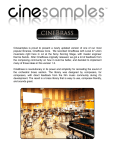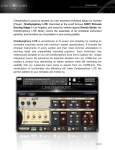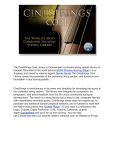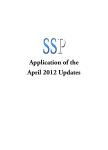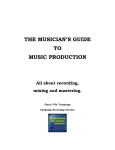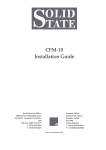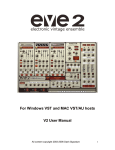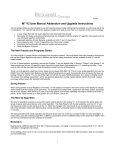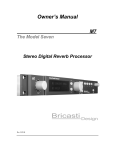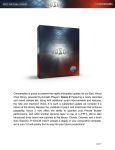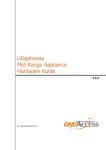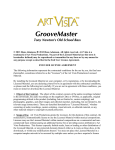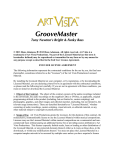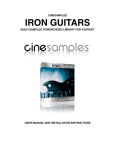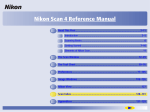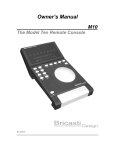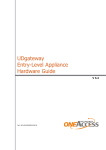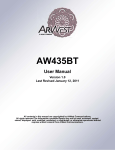Download User Manual - Cinesamples
Transcript
Cinesamples is proud to present a newly updated version of one of our most popular libraries, CineBrass PRO. We recorded CineBrass with Local 47 union musicians right here in LA at the Sony Scoring Stage, with master engineer Dennis Sands. After CineBrass originally released, we got a lot of feedback from the composing community on how it could be better, and decided to implement many of those ideas in this version 1.5. CineBrass is revolutionary in its power and simplicity for recreating the sound of the orchestral brass section. The library was designed by composers, for composers, with direct feedback from the film music community during itʼs development. The result is a brass library that is easy to use, composer-friendly, and sounds great. DENNIS SANDS Dennis is one of the most sought after mixers in Hollywood. His credit list is a sight to behold (Back to the Future, Forrest Gump, Shawshank Redemption, American Beauty, The Avengers), and includes some of our favorite scores. He continues to produce incredible-sounding mixes year after year. We were enormously honored to have him on this project; his ears, equipment, and general expertise are some of the most important parts of what youʼll get when you use CineBrass. THE SONY PICTURES SCORING STAGE The Sony Pictures Scoring Stage is the largest motion picture scoring venue in the world. The main scoring area has remained unchanged since the 1930s to preserve its unmatched acoustics and unique ambiance. It measures 93ʼ wide by 67ʼ long by 34ʼ high. One of the first scores recorded there was the Wizard of Oz (Herbert Stothart). Its success allowed the stage to become primarily dedicated to the art of the film score. John Williams has used the stage on many occasions for scores such as ET, Schindlerʼs List, War Horse, and The Adventures of Tin-Tin. Other scores recently recorded there include Toy Story 3 (Randy Newman), Spider-Man (Danny Elfman), Alice in Wonderland (Danny Elfman), Transformers: Dark of the Moon (Steve Jablonsky), Wall-E (Thomas Newman), The Amazing Spider-Man (James Horner) and Star Trek (Michael Giacchino). INSTRUMENTATION Recording union players in Los Angeles allowed us to select from a pool of active Hollywood studio musicians, some of whom are members of the Los Angeles Philharmonic. These stellar players can be heard on countless film and TV projects including: Indiana Jones 4, Monsters, Inc., Wall-E, Spider-Man 2, Family Guy, and The Simpsons. PATCH LIST 01 Trumpet Solo Articulations 02 Trumpet Solo True Legato 03 Trumpets Ensemble Muted Articulations 04 Trumpets Ensemble Harmon Mute Articulations 05 Horn Solo Articulations 06 Horn Solo True Legato PRO 07 Horns Ensemble Stopped and Fluttered 08 Horns Ensemble Triad Chords 09 Horns Ensemble Seventh Chords 10 Horns Ensemble Rips 11 Twelve Horn Ensemble Articulations 12 Twelve Horn Ensemble True Legato 13 Twelve Horn Ensemble Mutes 14 Trombone Solo Articulations 15 Trombone Solo True Legato PRO 16 Trombones Ensemble Muted Articulations 17 Trombones Ensemble Harmon Mute Articulations 18 Trombones Ensemble Fluttered 19 Tuba Solo Articulations 20 Tuba Solo True Legato PRO MULTIS 21 Full Brass Ensemble FX Part 1 22 Full Brass Ensemble FX Part 2 01 Concert Order - Full Articulations Standard 23 Full Brass Ensemble FX Part 3 02 Concert Order - Full Articulations Groups + FX 24 Full Brass Ensemble High Chords 03 Concert Order - Full Articulations Split Patches - Hrns-Tpts 25 Full Brass Ensemble Low Chords 04 Concert Order - Full Articulations Split Patches - Trmb-Tuba 26 Monster Low Brass Articulations 27 Monster Low Brass Scoops 28 Monster Low Brass Clusters 29 Monster Low Brass FX 30 Horns Ensemble fff Sustains and Shorts 31 Trumpets Ensemble Sustains and Tenuto The Patches Weʼve also included old school Short/Long Patches for people who may want more of a traditional setup. These consist of long patches with no legato and short patches that are eighths only with velocity sensitive dynamics. A lot of people still work this way so we decided to take the liberty of setting up these presets. They utilize the same samples as the articulations patches. True Legato True Legato means that we sampled all of the intervalic leaps throughout the ranges, both upwards and downwards, for each instrument. When you play a True Legato patch, it instantly analyzes the intervals you play, then plays the appropriate transitional leap between the notes. The result is a smooth and realistic legato performance. We did this at multiple dynamic levels for all sections, using our dynamic morphing to blend seamlessly from piano to forte. For version 1.5, weʼve tweaked our legato scripting extensively into what we think is some of the most realistic brass legato ever. Articulations Patches These patches contain sustain samples recorded at varying dynamics, as well as eighth note, quarter note, and half note shorts. Weʼve arranged the interface so that you can decide exactly how these samples will be triggered and how the dynamics will be controlled. You can play a line that includes any sample at any dynamic by striking the keys at different velocities, using simple keyswitching, or by utilizing a continuous midi controller. Eighths Staccato p to ff Quarters Tenuto p to ff Halves Marcato p to ff Sustains with smooth dynamic morphing All of the mapping in the Articulations Patches is dynamic, so you can select from five intuitive presets in the user interface. A custom mapping grid is offered for users who wish to customize the parameters beyond the presets. Every parameter and value is changeable and nearly any combination is possible. Of course, if you choose not to tweak, you can stick with one of the preset mappings (recommended). Note: The Articulations Patches also contain legato samples for your convenience. They are the same samples as on the true legato patches, so playing legato on an articulations patch is the same as playing a true legato patch. The MAPPING Tab - Articulations Presets We have provided different preset options to trigger these samples based on the different ways most composers like to work. This means you can intuitively use one patch for many applications, create more dynamic and natural lines, and ultimately improve your workflow. In the main Articulations patches you can choose from a variety of presets in the form of buttons on the left side of the MAPPING interface: •Velocity Map - The short articulations are mapped based on velocity from shortest to longest. Light taps will trigger the eighth note shorts, and hard hits will trigger half note shorts. Hold the sustain pedal down and hit a key to trigger the sustain samples, and overlap midi notes to trigger legato samples. Use the mod wheel to control dynamics for both long and short articulations. •Velocity Inverse Map - Similar to the Velocity Map, except the shorts are mapped inversely; from longest to shortest as velocity increases. Holding the sustain pedal will still give you sustains and legato, and the mod wheel still controls all dynamics. •Keyswitch Map - Playing soft will always trigger the sustain samples. Play with a velocity higher than 70 to trigger a short sample, and use keyswitches to decide which short you would like to use. Mod wheel controls all dynamics. •Keyswitch Velocity Dynamics Map - Use keyswitches to choose between eighth note, quarter note, half note, or sustain samples. Velocity will determine the dynamics of the short notes, mod wheel will control dynamics of sustain samples. •MIDI CC Map - Lower velocities will trigger sustain samples, and higher velocities will trigger short notes. Use mod wheel for dynamics. Controller #3 will let you choose which shorts are triggered - eighth, quarter, or half note shorts. You can adjust any of the presets should you desire, and the Custom Map button provides you with a blank set of assignments if you want to build your own. Simply adjust how each articulation will be triggered using the provided parameters - Velocity, Keyswitches, Sustain Pedal, or Continuous Midi Controllers. •Short/Sustain Order - If you decide to split sustain samples and short samples based on velocity, this will control whether high velocities trigger shorts and low velocities trigger sustains, or vice versa. •Short/Sustain Split - This will let you choose at which value the abovementioned split will occur. For example, you may want velocities above 100 to trigger sustain samples and below to trigger shorts. •Sustain Dynamics - Choose how the dynamics of the sustain samples will be controlled; with a controller or by velocity (the latter is not recommended). •Short Dynamics - Choose how the dynamics of the short articulations will be controlled; with a controller or by velocity. •Staccato Overlay - This feature will layer the eighth note samples over the sustain samples on high velocity. THis feature is useful for simulating sforzandos. Note: If you decide to use keyswitches, you are provided with a latching or nonlatching option. When a latching keyswitch is pressed, you will be stuck in that articulation until a different keyswitch is triggered or another parameter takes you to another articulation. If you choose non-latching, the keyswitch will need to be held down continuously in order to trigger that articulation. Double/Triple Tonguing On the articulations patches, we have added a feature that will allow you to easily play quick, short repetitions. For double-tonguing, hold down the non-latching C# keyswitch, displayed on the Kontakt keyboard in green, while playing eighth note samples. A second round robin will be triggered on the release of the key, allowing you to play quick passages without having to program them, or break your controller by hammering on the keys. For triple-tonguing, hold down the D# keyswitch. This script will calculate the time between attack and release, and play a third note equally spaced after the release. Give it a try! The SETTINGS Tab This tab provides you with even more control over the way the instrument will behave. The first thing you will notice in the top left section is the large Legato Speed knob and Legato Volume knob. These are useful if you want to adjust the length of the legato transitions, or if you want to tweak the volume of the transitions in relation to the sustain samples. When playing a very fast passage for example, you might want to turn up the legato speed and/or turn down the legato volume. Both of these knobs can be mapped to a CC controller. The mono/poly mode switch allows you to control whether the instrument will be completely monophonic - for single lines - or polyphonic. Our custom polyphonic legato scripting can play multiple legato lines at once. This will work best when playing parallel lines that donʼt stray too close together, or when playing chords. You can use the On/Off switch next to the Legato Speed Knob to turn the legato transitions completely off. This will cause the patch to behave more traditionally just sustain samples and shorts - so that you can play chords or combinations of notes without the legato scripting getting in the way. Beneath the Legato Speed Knob there is a dynamics fader that will allow you to compress the dynamic range of the instrument. For example, if you are controlling dynamics with the mod wheel, this slider will allow you to “zoom in” on a specific dynamic range and have the sound of the instrument affected less by extreme changes in the mod wheelʼs position. Across the bottom of the Settings tab, you will see more sample controls. When set to Random, the Round Robin switch will randomly cycle through different short samples to prevent the dreaded “machine-gun effect.” When set to Cycle, the engine will just cycle through the round robin samples in the same order every time. The RR reset, when set to ON, will reset the order of the round robin cycling after you have stopped hitting any midi keys. The RR reset knob controls how long it will take to reset. Turning it all the way down will make it reset in 1 second, and all the way up will cause it to reset in 10 seconds. Turning on the Sample Start control will let you use the knob to advance the sample start position. This will make the attack of the note sound less realistic by cutting off some of the attack, but can lead to increased tightness and responsiveness from the instrument. The Release Delay knob allows you to control how long after you release a key the release sample will play, and the Release Trigger switch allows you to turn releases off completely. This will sound less realistic but require less CPU. We have also provided multiple effects for your convenience - HiPass and LowPass filters, Delay, Stereo Imaging, Chorus, Flanger, Distortion and Compression. When using these built-in Kontakt effects keep in mind that they can be very heavy on your CPU. On that note: CineBrass is a next generation library and uses cutting edge scripting techniques, which can be very CPU intensive. For best results you should run this library at a buffer of 256 or higher. The MIXER Tab Weʼve included Full Mix, Close, Room, and Surround mics as mixing options in CineBrass. You can load and unload the different mic samples from your RAM manually by using the on/off switches above their respective faders, and apply reverb using the send knobs in conjunction with the blue reverb knob/switch in the bottom right. Click the “Preset” button below the reverb knob to choose from seven different impulse responses taken from the famous Bricasti M7 hardware reverb. An EQ is also available on the right if you would like to tweak the sound further. For quick and easy access to different mixing options, cycle through the presets on the left. The various options make use of different mic configurationsʼ unique sound and will give you tremendous flexibility when working in a variety of cinematic settings. Recording CineBrass Sampling in Los Angeles is no easy task. Especially when you want to do it the right way. This library is the first of itʼs kind, because it is the first commercial library to be recorded under a special AFM (American Federation of Musicians) Sampling Agreement. The product of this, is that for every purchase, a percentage of the sales go directly to the musicians who played on the CineBrass session. Not only does it go to the musicians, but weʼve extended it to the copyists, the engineers and everyone who had a critical role in producing the library. Important to note that this does not effect the user agreement, and CineBrass can be used like any other Cinesamples library in your music productions.Why do this? We want to keep recording here in Los Angeles, with the best musicians, at the best scoring stages in the world. We are grateful to the AFM for having the vision to do this with us, and we look forward to extending this to all our future libraries. Be sure to check out the screencast videos on the Cinesamples website to get a detailed look at the library! Enjoy CineBrass 1.5!










